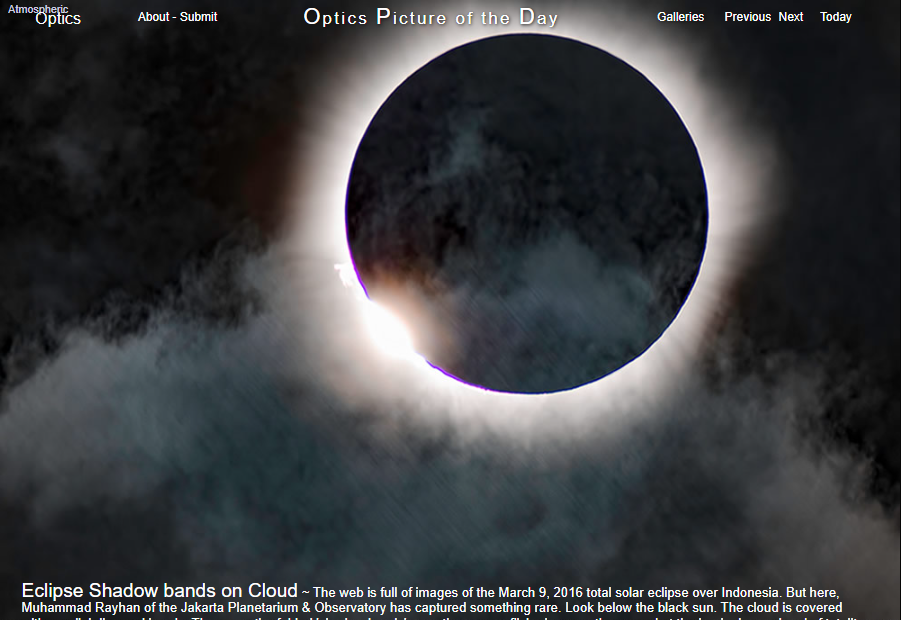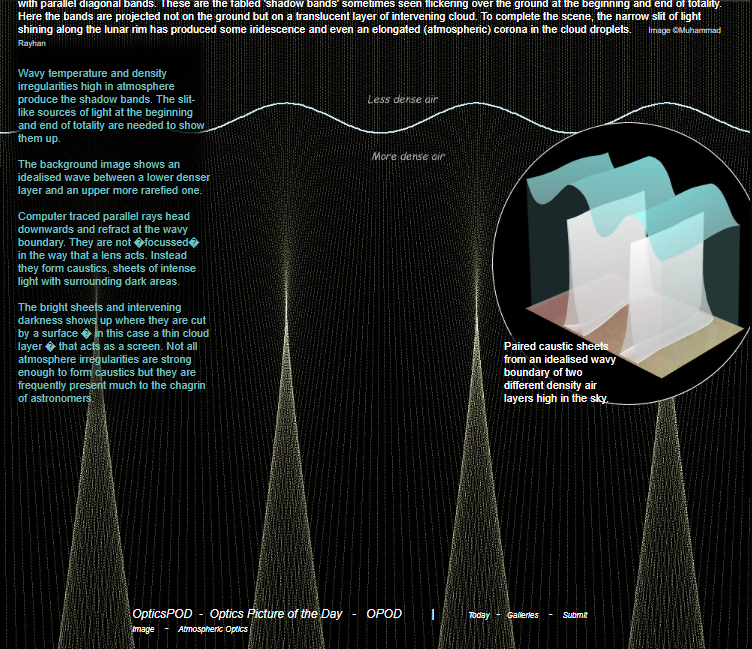Eclipse Shadow Bands - OPOD
Eclipse Shadow Bands: An Enigmatic Atmospheric Phenomenon
Eclipse shadow bands, also known as shadow waves, are a captivating and elusive phenomenon that can occur during a total solar eclipse. While most people focus on capturing images of the eclipsed sun, Muhammad Rayhan of the Jakarta Planetarium & Observatory managed to capture something truly rare - shadow bands projected on a layer of translucent cloud below the black sun. This mesmerizing sight adds another layer of intrigue to an already awe-inspiring celestial event.
Shadow bands are parallel diagonal bands that appear to flicker over the ground just before and after totality. They are not commonly observed, making them a subject of fascination for both amateur and professional astronomers. Traditionally, these bands are seen on the Earth's surface, but in this particular instance, they were projected onto a cloud layer, creating a truly unique spectacle. Additionally, the narrow slit of light shining along the lunar rim created iridescence and even an elongated corona within the cloud droplets, further enhancing the ethereal beauty of the scene.
But what causes these enigmatic shadow bands? They are a result of wavy temperature and density irregularities high in the atmosphere. During a total solar eclipse, the narrow sources of light at the beginning and end of totality are essential for revealing these bands. The interaction between the light rays and the atmospheric irregularities leads to the formation of caustics - sheets of intense light with surrounding dark areas. These caustic sheets and the darkness in between become visible when they intersect with a surface, such as a thin cloud layer, acting as a screen.
The irregularities in the atmosphere that produce shadow bands are not always strong enough to form caustics. However, they are frequently present, much to the chagrin of astronomers who strive to capture these elusive phenomena. To understand the formation of shadow bands more comprehensively, it helps to visualize an idealized wave between a lower, denser layer and an upper, more rarefied one. Computer-traced parallel rays of light refract at the wavy boundary, creating caustics that manifest as bright sheets and intervening darkness.
In the sky, paired caustic sheets form from the idealized wavy boundary between two different density air layers. These sheets give rise to the mesmerizing parallel diagonal bands that are observed during a total solar eclipse. The intricate dance of light and shadow creates a visual spectacle that adds to the already enchanting experience of witnessing an eclipse.
While shadow bands are not always visible during an eclipse, their appearance adds an extra layer of magic and mystique to an already awe-inspiring celestial event. Capturing these elusive phenomena requires a keen eye and a bit of luck, as they depend on various atmospheric conditions. As astronomers continue to study and document these fascinating shadow bands, we can only marvel at the wonders of our atmosphere and the captivating interplay between light and shadow.

Eclipse Shadow bands on Cloud ~ The web is full of images of the March 9, 2016 total solar eclipse over Indonesia. But here, Muhammad Rayhan of the Jakarta Planetarium & Observatory has captured something rare. Look below the black sun. The cloud is covered with parallel diagonal bands. These are the fabled 'shadow bands' sometimes seen flickering over the ground at the beginning and end of totality. Here the bands are projected not on the ground but on a translucent layer of intervening cloud. To complete the scene, the narrow slit of light shining along the lunar rim has produced some iridescence and even an elongated (atmospheric) corona in the cloud droplets.
Image ©Muhammad Rayhan

Wavy temperature and density irregularities high in atmosphere produce the shadow bands. The slit-like sources of light at the beginning and end of totality are needed to show them up.
The background image shows an idealised wave between a lower denser layer and an upper more rarefied one.
Computer traced parallel rays head downwards and refract at the wavy boundary. They are not �focussed� in the way that a lens acts. Instead they form caustics, sheets of intense light with surrounding dark areas.
The bright sheets and intervening darkness shows up where they are cut by a surface � in this case a thin cloud layer � that acts as a screen. Not all atmosphere irregularities are strong enough to form caustics but they are frequently present much to the chagrin of astronomers.
Paired caustic sheets from an idealised wavy boundary of two different density air layers high in the sky.
Note: this article has been automatically converted from the old site and may not appear as intended. You can find the original article here.
Reference Atmospheric Optics
If you use any of the definitions, information, or data presented on Atmospheric Optics, please copy the link or reference below to properly credit us as the reference source. Thank you!
-
<a href="https://atoptics.co.uk/blog/eclipse-shadow-bands-opod/">Eclipse Shadow Bands - OPOD</a>
-
"Eclipse Shadow Bands - OPOD". Atmospheric Optics. Accessed on November 16, 2024. https://atoptics.co.uk/blog/eclipse-shadow-bands-opod/.
-
"Eclipse Shadow Bands - OPOD". Atmospheric Optics, https://atoptics.co.uk/blog/eclipse-shadow-bands-opod/. Accessed 16 November, 2024
-
Eclipse Shadow Bands - OPOD. Atmospheric Optics. Retrieved from https://atoptics.co.uk/blog/eclipse-shadow-bands-opod/.